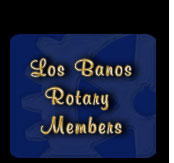




Los Banos Rotary Club History
Parking
Meters Are Explained By Company Man
Bradley Spencer,
the man who sold a majority of the city council on the advisability of installing
parking meters in Los Banos, did a pretty complete job of “selling”
the idea to members of the Rotary Club Tuesday noon, as he outlined the benefits
that might be derived from the installation and explained the workings of the
“Mark time” meter that will be installed here.
Spencer explained
that parking meters are simply an evolution of the time-worn practice of restricted
parking. In the old days a police officer would place chalk marks on the tires
of parked cars and periodically check to see if allowed parking time had been
violated. Today, parking meters do the job with much greater efficiency and at
the same time are a source of important money for operation of municipal government.
Speaking of the parking situation in Los Banos, Spencer told of a series
of surveys made here by his company during the month of June. On a Monday morning,
considered a low point in traffic congestion, a survey at 9:00 a.m. showed only
75 available parking places along the four blocks that are to be included in the
metered area. At the same time on the following Saturday there were only 24 available
parking spaces.
Stationing himself near the H street intersection on
Sixth street at 11:00 a.m., Spencer saw 100 motorists move in and out of parking
spaces along the two blocks of Sixth between H and J. During the same period he
saw 33 motorists drive down Sixth street and make a U turn at H because they were
unable to find parking space on the east side of Sixth.
A more recent
survey, conducted Tuesday morning at 11:30, showed 50 available spaces in the
four blocks, most of which were on I street, between Fifth and Sixth. Of 93 possible
parking spaces along the two blocks of Sixth street between H and J, only eight
empty spaces were counted.
Parking meters, Spencer pointed out, are
not the answer to an overly congested parking problem. Off street parking is the
only solution and stated that large stores in the larger cities have recognized
this fact by providing free parking space for their customers.
However,
parking meters do permit faster turn-over of available space and benefits the
merchant in that more customers may find parking facilities adjacent to their
store. Housewives, farmers and tradesmen who have shopping to do or business to
transact in metered areas generally like the convenience afforded and are more
than willing to pay for same, Spencer declared.
Parking meters also
eliminate the “sleeper” or all-day parker, Spencer explained. He cited
observations made here in Los Banos, wherein license numbers were taken of all
cars at 9:00 a.m. Five cars found parked at that time were still in the same place
at noon; while in the afternoon 23 cars were found permanently parked. On H. street,
he said, there are at least 80 possible parking places where free all-day parking
could be found.
Spencer said that the Mark Time meter manufactured by his
company was remarkably simple in construction and required a minimum of upkeep.
Repairs for the city of Denver over the past five years have averaged less than
40c a year for each meter. Each meter has a foolproof collection box that cannot
be opened without breaking a small metal seal that is attached by the city treasurer.
The box is identical in construction to the one used on public telephones throughout
the United States.
As a source of revenue, Spencer stated that in California
parking meters have averaged approximately $81 per meter per year. The original
cost is $58 per meter, installed. The manufacturer retains 50 per cent of the
income of the machines each month until they are paid for, and the city gets the
other 50 per cent. When entirely paid for, estimated to be about 16 months, they
become the property of the city and all subsequent revenue goes to the city to
be used for street maintenance, traffic control, etc.
The speaker was
introduced by Councilman Frank Peluso.
August 13, 1946
© Copyright 2009 by
Los Banos Enterprise, Rotary Club 585 & Memorable Places Web Design of Los Banos


